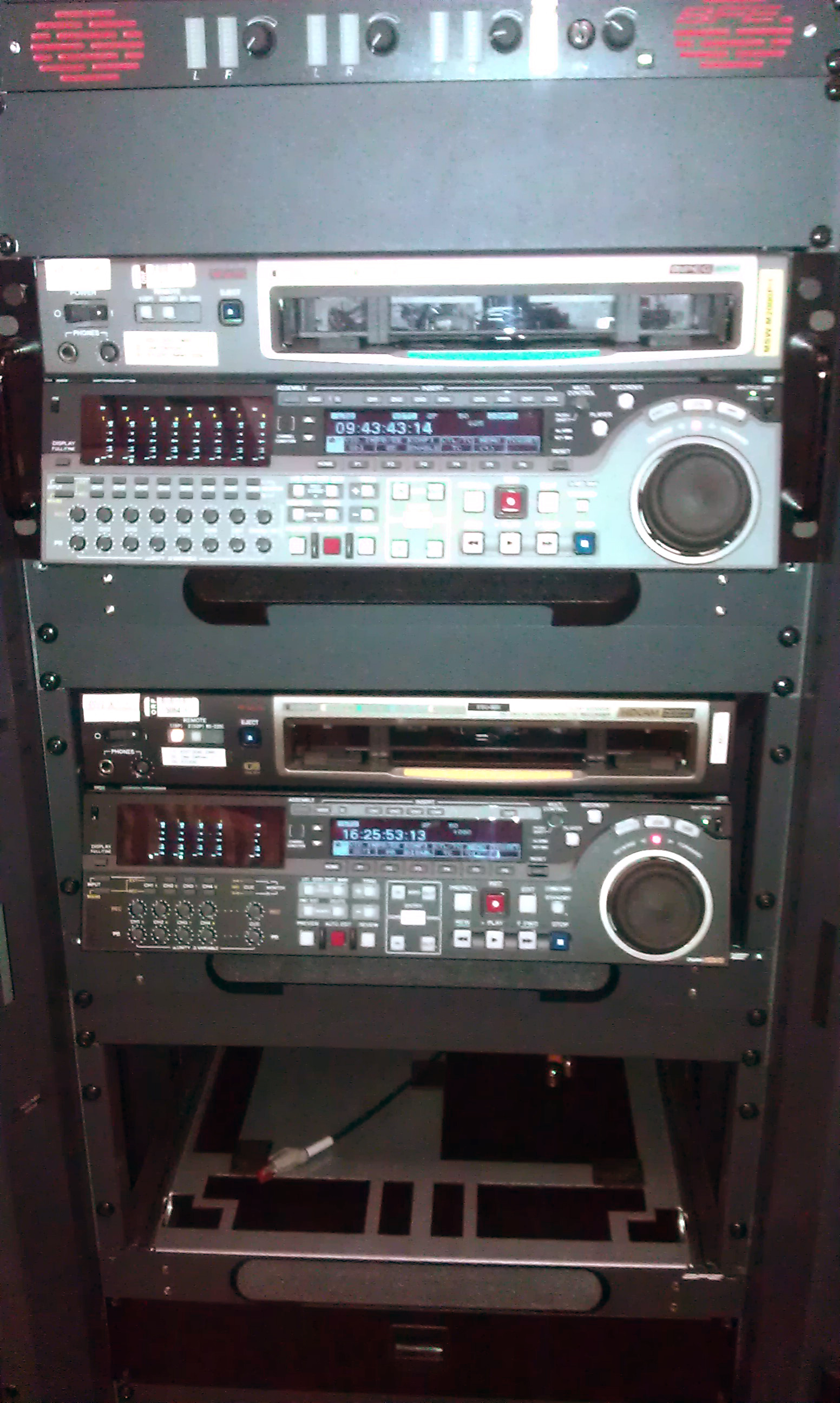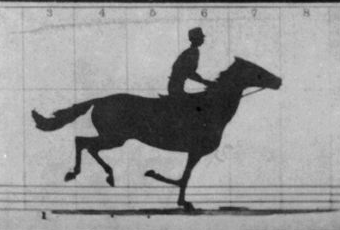|
Serial Data Transport Interface
Serial Data Transport Interface is a way of transmitting data packets over a serial digital interface (SDI) datastream. This means that standard SDI infrastructure can be used. Developed to address the needs of the growing number of compressed video standards ( DV, DVCPRO, BetaSX, MPEG2) it allows lossless transfer of data to other devices which have the same codec, for example DV to DV or SX to SX. Using a standard SDI transport, the extra data is placed within normal active video, between Start of Active Video (SAV), and End of Active Video (EAV). This gives 1440 10-bit words of data at (1920 words in the 8-bit standard). If an SDTI stream is viewed using a standard SDI device, then the raw data can be seen as a small strip along the left-hand side (usually in purple). The DVCAM SDTI has video data at the top, control data in the middle ( Timecode, etc.) and audio at the bottom just like it is organised on the tape. Because SDTI is used for compressed data the area used is ... [...More Info...] [...Related Items...] OR: [Wikipedia] [Google] [Baidu] |
Serial Digital Interface
Serial digital interface (SDI) is a family of digital video Interface (computing), interfaces first standardized by SMPTE (The Society of Motion Picture and Television Engineers) in 1989. For example, ITU-R BT.656 and SMPTE 259M define digital video interfaces used for Broadcasting, broadcast-grade video. A related standard, known as high-definition serial digital interface (HD-SDI), is standardized in SMPTE 292M; this provides a nominal data rate of 1.485 Gbit/s. Additional SDI standards have been introduced to support increasing video resolutions (High definition video, HD, Ultra high definition, UHD and beyond), High frame rate, frame rates, 3D video, stereoscopic (3D) video, and color depth. Dual link HD-SDI consists of a pair of SMPTE 292M links, standardized by SMPTE 372M in 1998; this provides a nominal 2.970 Gbit/s interface used in applications (such as digital cinema or HDTV 1080P) that require greater fidelity and resolution than standard HDTV can provide. 3 ... [...More Info...] [...Related Items...] OR: [Wikipedia] [Google] [Baidu] |
DV (video Format)
DV (from ''Digital Video'') is a family of codecs and Videotape, tape formats used for storing digital video, launched in 1995 by a consortium of camcorder, video camera manufacturers led by Sony and Panasonic. It includes the recording or cassette formats DV, MiniDV, HDV, DVCAM, DVCPro, DVCPro50, DVCProHD, Digital8, and Digital-S. DV has been used primarily for video recording with camcorders in the amateur and professional sectors. DV was designed to be a standard for home video using digital data instead of Analog video, analog. Compared to the analog 8 mm video format, Video8/Hi8, VHS-C and VHS formats, DV features a higher video resolution (on par with professional-grade Digital Betacam); it records uncompressed 16-bit Pulse-code modulation, PCM audio like Compact Disc Digital Audio, CD. The most popular tape format using a DV codec was MiniDV; these cassettes measured just 6.35 mm/¼ inch, making it ideal for video cameras and rendering older analog formats obsolete. In the ... [...More Info...] [...Related Items...] OR: [Wikipedia] [Google] [Baidu] |
DVCPRO
DV (from ''Digital Video'') is a family of codecs and tape formats used for storing digital video, launched in 1995 by a consortium of video camera manufacturers led by Sony and Panasonic. It includes the recording or cassette formats DV, MiniDV, HDV, DVCAM, DVCPro, DVCPro50, DVCProHD, Digital8, and Digital-S. DV has been used primarily for video recording with camcorders in the amateur and professional sectors. DV was designed to be a standard for home video using digital data instead of analog. Compared to the analog Video8/Hi8, VHS-C and VHS formats, DV features a higher video resolution (on par with professional-grade Digital Betacam); it records uncompressed 16-bit PCM audio like CD. The most popular tape format using a DV codec was MiniDV; these cassettes measured just 6.35 mm/¼ inch, making it ideal for video cameras and rendering older analog formats obsolete. In the late 1990s and early 2000s, DV was strongly associated with the transition from analog to digi ... [...More Info...] [...Related Items...] OR: [Wikipedia] [Google] [Baidu] |
Betacam
Betacam is a family of half-inch professional videocassette products developed by Sony in 1982. In colloquial use, ''Betacam'' singly is often used to refer to a Betacam camcorder, a Betacam tape, a Betacam video recorder or the format itself. All Betacam variants from analog Betacam, Betacam SP and Digital Betacam, HDCAM and HDCAM SR use the same shape videocassettes, meaning vaults and other storage facilities do not have to be changed when upgrading to a new format. The cassette shell and case for each Betacam cassette is colored differently depending on the format, allowing for easy visual identification. There is also a mechanical key that allows a video tape recorder to identify which format has been inserted. The cassettes are available in two sizes: S (short or small) and L (long or large). The Betacam camcorder can only load S magnetic tapes, while television studio sized video tape recorders (VTR) designed for video editing can play both S and L tapes. The format s ... [...More Info...] [...Related Items...] OR: [Wikipedia] [Google] [Baidu] |
MPEG2
MPEG-2 (a.k.a. H.222/H.262 as was defined by the ITU) is a standard for "the generic coding of moving pictures and associated audio information". It describes a combination of lossy video compression and lossy audio data compression methods, which permit storage and transmission of movies using currently available storage media and transmission bandwidth. While MPEG-2 is not as efficient as newer standards such as H.264/AVC and H.265/HEVC, backwards compatibility with existing hardware and software means it is still widely used, for example in over-the-air digital television broadcasting and in the DVD-Video standard. Main characteristics MPEG-2 is widely used as the format of digital television signals that are broadcast by terrestrial (over-the-air), cable, and direct broadcast satellite TV systems. It also specifies the format of movies and other programs that are distributed on DVD and similar discs. TV stations, TV receivers, DVD players, and other equipment are ... [...More Info...] [...Related Items...] OR: [Wikipedia] [Google] [Baidu] |
Timecode
A timecode (alternatively, time code) is a sequence of numeric codes generated at regular intervals by a timing synchronization system. Timecode is used in video production, show control and other applications which require temporal coordination or logging of recording or actions. Video and film In video production and filmmaking, SMPTE timecode is used extensively for synchronization, and for logging and identifying material in recorded media. During filmmaking or video production shoot, the camera assistant will typically log the start and end timecodes of shots, and the data generated will be sent on to the editorial department for use in referencing those shots. This shot-logging process was traditionally done by hand using pen and paper, but is now typically done using shot-logging software running on a laptop computer that is connected to the timecode generator or the camera itself. The SMPTE family of timecodes are almost universally used in film, video and audio pr ... [...More Info...] [...Related Items...] OR: [Wikipedia] [Google] [Baidu] |
SMPTE
The Society of Motion Picture and Television Engineers (SMPTE) (, rarely ), founded by Charles Francis Jenkins in 1916 as the Society of Motion Picture Engineers or SMPE, is a global professional association of engineers, technologists, and executives working in the media and entertainment industry. As an internationally recognized standards organization, SMPTE has published more than 800 technical standards and related documents for broadcast, filmmaking, digital cinema, audio recording, information technology (IT), and medical imaging. SMPTE also publishes the ''SMPTE Motion Imaging Journal'', provides networking opportunities for its members, produces academic conferences and exhibitions, and performs other industry-related functions. SMPTE membership is open to any individual or organization with an interest in the subject matter. In the US, SMPTE is a 501(c)(3) organization, 501(c)3 non-profit charitable organization. History An informal organizational meeting was hel ... [...More Info...] [...Related Items...] OR: [Wikipedia] [Google] [Baidu] |
HDTV
High-definition television (HDTV) describes a television or video system which provides a substantially higher image resolution than the previous generation of technologies. The term has been used since at least 1933; in more recent times, it refers to the generation following standard-definition television (SDTV). It is the standard video format used in most broadcasts: Terrestrial television, terrestrial broadcast television, cable television, satellite television. Formats HDTV may be transmitted in various formats: * 720p (): 921,600 pixels * 1080i () interlaced scan: 1,036,800 pixels (≈1.04Mpx). * 1080p () progressive scan: 2,073,600 pixels (≈2.07Mpx). ** Some countries also use a non-standard CTA resolution, such as : 777,600 pixels (≈0.78Mpx) per field or 1,555,200 pixels (≈1.56Mpx) per frame When transmitted at two megapixels per frame, HDTV provides about five times as many pixels as SD (standard-definition television). The increased resolution provides for a cl ... [...More Info...] [...Related Items...] OR: [Wikipedia] [Google] [Baidu] |
Serial Digital Interface
Serial digital interface (SDI) is a family of digital video Interface (computing), interfaces first standardized by SMPTE (The Society of Motion Picture and Television Engineers) in 1989. For example, ITU-R BT.656 and SMPTE 259M define digital video interfaces used for Broadcasting, broadcast-grade video. A related standard, known as high-definition serial digital interface (HD-SDI), is standardized in SMPTE 292M; this provides a nominal data rate of 1.485 Gbit/s. Additional SDI standards have been introduced to support increasing video resolutions (High definition video, HD, Ultra high definition, UHD and beyond), High frame rate, frame rates, 3D video, stereoscopic (3D) video, and color depth. Dual link HD-SDI consists of a pair of SMPTE 292M links, standardized by SMPTE 372M in 1998; this provides a nominal 2.970 Gbit/s interface used in applications (such as digital cinema or HDTV 1080P) that require greater fidelity and resolution than standard HDTV can provide. 3 ... [...More Info...] [...Related Items...] OR: [Wikipedia] [Google] [Baidu] |
Film And Video Technology
A film, also known as a movie or motion picture, is a work of visual art that simulates experiences and otherwise communicates ideas, stories, perceptions, emotions, or atmosphere through the use of moving images that are generally, since the 1930s, synchronized with sound and (less commonly) other sensory stimulations. Etymology and alternative terms The name "film" originally referred to the thin layer of photochemical emulsion on the celluloid strip that used to be the actual medium for recording and displaying motion pictures. Many other terms exist for an individual motion-picture, including "picture", "picture show", "moving picture", "photoplay", and "flick". The most common term in the United States is "movie", while in Europe, "film" is preferred. Archaic terms include "animated pictures" and "animated photography". "Flick" is, in general a slang term, first recorded in 1926. It originates in the verb flicker, owing to the flickering appearance of early films. ... [...More Info...] [...Related Items...] OR: [Wikipedia] [Google] [Baidu] |



